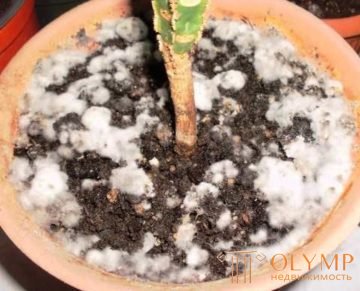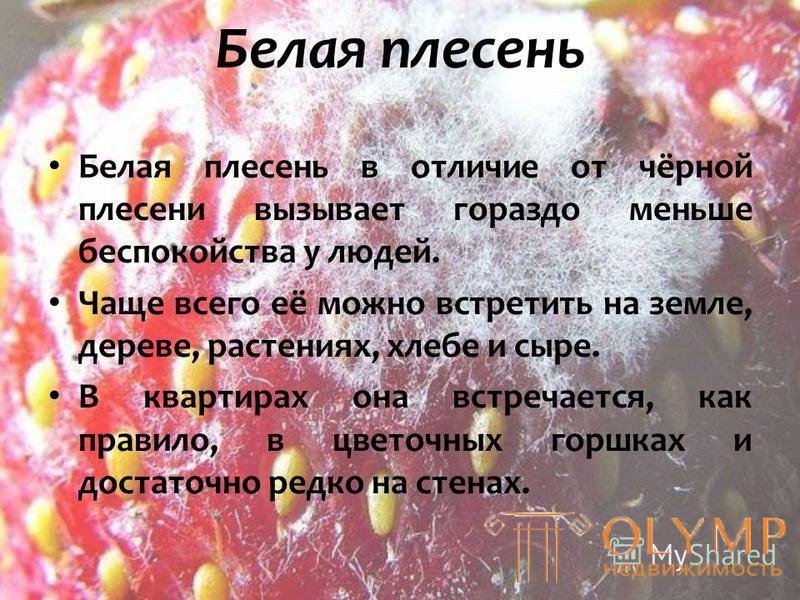

White mold appears on the ground in flower pots due to improper care or the influence of negative external factors. Plaque usually begins to spread at the point of contact between the soil and the pot. It can be white or brown in color and has a high propagation velocity.
There are always a lot of controversy in the air. Under favorable environmental conditions, colonies of fungi are formed from them, which begin to multiply rapidly.
Content
Faced with such a problem as mold in a flower pot, how to get rid of it depends on its type and causes of occurrence.
Black mold occurs due to high humidity. It may have different shades.
When this type of mold appears, you should immediately begin the process of getting rid of it, since it is the most dangerous for humans . Interaction with it can lead to an allergic reaction and respiratory failure.

White mold often appears in the soil, on trees and plants. The most common form that predominantly appears in flower pots.
In appearance, this fungus is similar to salt stains. They differ in structure. Salt deposits are microcrystalline formations that do not lose their shape. Mold is easily pounded in the hands.




If plaque in the form of white, grayish or green spots is observed on the soil, then it can be salted out - the result of chemical reactions, has no relation to mold. It adversely affects not only the external part of the soil, but also penetrates into the inner layers.

Fungi of the blue (on the tree)
Blue fungi affect the fiber of wood, and the surface of a wooden house is not painted at all in a noble gray-blue color. Rotting fungi also attack wood only. Rot there are several types - bacterial, brown and white. Bacterial rot corrodes wood from the inside. The affected material becomes noticeably gray or dark, and its strength deteriorates markedly — the bacterium causes local decomposition of cellulose.

If there is mold in the ground and it smells of rot, then you need to adjust the schedule for watering the plant. It is recommended to reduce the frequency of irrigation and reduce the volume of fluid . Some plants have enough wet soil. Otherwise, the roots may start to rot, leading to fungal infections.
With abundant but rare watering, it is necessary to systematically loosen the soil. Moreover, should be affected deep layers. But you should be careful, because you can damage the root system .
How to get rid of mold in flower pots without harming the plant:
So that tillage has an effective result, it is periodically required to loosen its top layer. This will lead to a uniform distribution of moisture and prevent its stagnation.
If the ground in the pot is covered with white mold, then it is necessary to water the plant with a solution of water with citric acid at intervals of at least 2 times a month. For 1 cup of the liquid is taken 0.5 tsp of acid.
If mold appeared in a flower pot, how to get rid of it quickly and efficiently? An effective way to eliminate the fungal infection is to transplant a plant into a new pot with full replacement of the soil. Soil should be selected taking into account all the rules during planting. For certain plants, it is necessary to determine in advance the optimum humidity.
To get rid of the infection and the smell of mold, you can disinfect the soil according to the instructions:
It is possible to get rid of a mold by means of chemical means (fungicides). They can be purchased at flower shops.
But choosing such a method should be considered:
The fact that plants can be affected by various diseases has been known to mankind since ancient times: ever since people began to grow crops purposefully. At the same time, the first means and methods of their protection appeared - spraying the extract of olives, fumigating with sulfur, soaking with wine. Now the problems are eliminated with the help of fungicides.
What it is? Fungicides are chemical preparations designed to prevent the development or destruction of pathogenic fungi and bacteria that are the causative agents of numerous diseases. The range of these drugs is wide and varied. They have a different purpose, range of action, are available in the form of suspensions, powders, emulsions and solutions. Even knowing what a fungicide is, it is not so easy to understand this variety and choose the right pesticide. To do this, you need to have at least a general understanding of the properties and features of the classification of drugs.
The active substance in the first is the chemical compound, and secondly - the special bacteria that are antagonists of pathogenic fungi and causing their death. The main advantage of biofungicides is the low toxicity, which they demonstrate with very high efficiency. That is why these drugs are so widespread among summer residents and farmers.
The first ones do not have in their composition heavy metals, they dissolve well in water and are combined with other preparations. But at the same time, they are extremely unstable compounds that persist in the soil for long. Inorganic fungicides are made on the basis of compounds of sulfur, nickel, manganese, potassium and other elements. They are far from compatible with each drug, they can accumulate in the soil and persist there for a long time.
The former are used for the treatment of not yet infected, apparently healthy crops for the purposes of prevention. As a rule, protective fungicides are used during periods when the risk of pathogens is too high. They help prevent infection and preserve crop yields.
Healing (or curative) drugs are used after the infection has already occurred, the first symptoms of the disease have appeared. The active substance contained in the composition, suppresses the development of the pathogen, resulting in a plant recovering.
Fungicide contact action interacts with the pathogen only on the surface, not penetrating into the plant. Thanks to him, pathogens of fungal diseases die in the development phase. But you need to process the plants very carefully, covering all parts of the crop.
The validity of such a drug is 10-12 days or until the first heavy rain. After this processing should be repeated. In total, it can be produced 6-8 times per season. The effectiveness of the drug depends on its quantity, duration, durability, ability to stay on the surface of the plant.
Systemic fungicide easily penetrates into plants, moving through the vessels and penetrating into all parts, thereby protecting the culture from fungal infection. Some drugs are used to prevent diseases, but most of them are capable of treating fungal diseases, even if the contact pesticide is impotent.
Systemic fungicides of the new generation have two undeniable advantages. First, they are able to effectively deal with various fungal diseases. Secondly, they have a number of additional properties (for example, they can act as insecticides).
It is advisable to use the drugs until the first signs of the disease are revealed. Processing can be performed even if the infection has already begun. The main thing is to choose an effective drug. Apply systemic fungicides less frequently than contact fungi (two or three times during the season). Usually it is enough that fungal diseases and infections do not damage the cultivated plants.
Recently, they began to produce fungicides containing several active substances. They are complex drugs that combine the main advantages of contact and system means.
For farmers and gardeners today, a large number of universal fungicides are available, which are suitable for dressing and soil treatment, as well as for spraying crops during the growing season.
Applying the wrong tool can get the opposite effect . And sometimes you can not use chemical reagents to eliminate moldy spots.
The advantage is to give organic products that affect the soil, and make it unfavorable for the development of the fungus.
Why it is necessary to get rid of mold and it should not be allowed to spread:
If you do not fight the moldy fungus, the plant will rot and die.
The reasons why a fungus forms on the surface of the soil can be several:
Excessive moisture and rare airing contribute to the rapid rate of mold spread . The most common time of occurrence of infection are the autumn and spring periods. At these intervals, cold air accumulates indoors, which leads to a slow evaporation of moisture from the ground surface. As a result, there is stagnation of fluid and the spread of fungal spores.
The cause of the fungus can be increased dampness in the house. This may be due to a poor communication system or the presence of a basement.
What to do to prevent fungus in flower pots:
In the absence of signs of infection for the prevention should be treated with potassium permanganate . The procedure should be carried out 1 time per month. But you can not use too concentrated solution , it can lead to the death of the plant.
Another popular remedy is garlic. It prevents the development of fungus. Garlic is cut into several pieces and placed next to the stem of the plant during watering. After the soil dries, it is removed.
For the prevention of garlic is recommended to use 1 time per week. For the treatment of affected land, the frequency of its use is 10-15 times a month.
If you regularly carry out preventive measures, you can avoid such problems as mold and the smell of rot. The process of getting rid of the fungus is much more complicated and takes more time. When creating favorable conditions for plant growth and the acquisition of high-quality soil, the probability of a fungus infecting the ground is minimal. Therefore, it is necessary to ensure systematic ventilation, adequate lighting and an optimal level of air humidity .
Houseplants should not be in a draft. Best suited special shelves or racks for flowers.
If there are indoor plants in the house, it is not advisable to use a humidifier. As with an increased level of humidity, favorable conditions are created for the development of infection.
In order not to think about the question of how to remove the mold from the ground, you should follow some tips :
Before breeding certain types of plants, you should be familiar with the features of their growth and follow the recommendations for their watering.
Что бы оставить комментарий войдите
Комментарии (0)